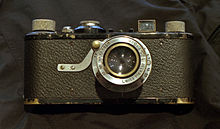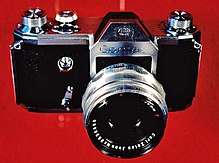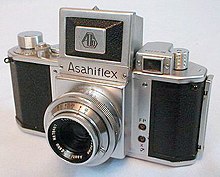History of the camera: Difference between revisions
| [pending revision] | [pending revision] |
Undid revision 308872142 by 204.185.129.125 (talk) |
|||
| Line 6: | Line 6: | ||
===First exposure=== |
===First exposure=== |
||
cheese |
|||
[[Joseph Nicéphore Niépce ]] took the first photograph by coating a [[pewter]] plate with [[bitumen]] and exposing the plate to light in 1814. The bitumen hardened where light struck. The unhardened areas were then dissolved away. |
|||
The camera has been improved in many ways, and the shape and size has been updated throughout history to fit modern times. |
|||
==Daguerreotypes and calotypes== |
==Daguerreotypes and calotypes== |
||
Revision as of 15:45, 31 August 2009

The first photograph was made in 1814 by Joseph Nicéphore Niépce using a sliding wooden box camera made by Charles and Vincent Chevalier in Paris, the photograph was not permanent though and it faded. Niépce built on a discovery by Johann Heinrich Schultz (1724): a silver and chalk mixture darkens under exposure to light. While this was the introduction of photography, the history of the camera can be traced back much further. Photographic cameras were a development of the camera obscura, a device dating back to the Book of Optics (1021) of the Iraqi Arab scientist Ibn al-Haytham (Alhacen),[1] which uses a pinhole or lens to project an image of the scene outside onto a viewing surface.
Before the invention of photographic lapel processes there was no way to preserve the images produced by these cameras apart from manually tracing them. The earliest cameras were room-sized, with space for one or more people inside; these gradually evolved into more and more compact models such as that by Niépce's time portable handheld cameras suitable for photography were readily available. The first camera that was small and portable enough to be practical for photography was built by Johann Zahn in 1685, though it would be almost 150 years before such an application was possible.
First exposure
cheese
Daguerreotypes and calotypes
Louis Jacques Daguerre and Joseph Nicéphore Niépce (who was Daguerre's partner, but died before their invention was completed) invented the first practical photographic method, which was named the daguerreotype, in 1836. Daguerre coated a copper plate with silver, then treated it with iodine vapour to make it sensitive to light. The image was developed by mercury vapor and fixed with a strong solution of ordinary salt. William Fox Talbot perfected a different process, the calotype, in 1840. Both used cameras that were little different from Zahn's model, with a sensitized plate or sheet of paper placed in front of the viewing screen to record the image. Focusing was generally via sliding boxes.
Dry plates

Collodion dry plates had been available since 1855, thanks to the work of Désiré van Monckhoven, but it was not until the invention of the gelatine dry plate in 1871 by Richard Leach Maddox that they rivaled wet plates in speed and quality. Also, for the first time, cameras could be made small enough to be hand-held, or even concealed. There was a proliferation of various designs, from single- and twin-lens reflexes to large and bulky field cameras, handheld cameras, and even cameras disguised as pocket watches, hats, or other objects.
The shortened exposure times that made candid photography possible also necessitated another innovation, the mechanical shutter. The very first shutters were separate accessories, though built-in shutters were common by the turn of the century.
Kodak and the birth of film

The use of photographic film was pioneered by George Eastman, who started manufacturing paper film in 1885 before switching to celluloid in 1889. His first camera, which he called the "Kodak," was first offered for sale in 1888. It was a very simple box camera with a fixed-focus lens and single shutter speed, which along with its relatively low price appealed to the average consumer. The Kodak came pre-loaded with enough film for 100 exposures and needed to be sent back to the factory for processing and reloading when the roll was finished. By the end of the 19th century Eastman had expanded his lineup to several models including both box and folding cameras.
In 1900, Eastman took mass-market photography one step further with the Brownie, a simple and very inexpensive box camera that introduced the concept of the snapshot. The Brownie was extremely popular and various models remained on sale until the 1960s.
Despite the advances in low-cost photography made possible by Eastman, plate cameras still offered higher-quality prints and remained popular well into the 20th century. To compete with rollfilm cameras, which offered a larger number of exposures per loading, many inexpensive plate cameras from this era were equipped with magazines to hold several plates at once. Special backs for plate cameras allowing them to use film packs or rollfilm were also available, as were backs that enabled rollfilm cameras to use plates.
35mm


See also: History of 135 film
Oskar Barnack, who was in charge of research and development at Leitz, decided to investigate using 35mm cine film for still cameras while attempting to build a compact camera capable of making high-quality enlargements. He built his prototype 35mm camera (Ur-Leica) around 1913, though further development was delayed for several years by World War I. Leitz test-marketed the design between 1923 and 1924, receiving enough positive feedback that the camera was put into production as the Leica I (for Leitz camera) in 1925. The Leica's immediate popularity spawned a number of competitors, most notably the Contax (introduced in 1932), and cemented the position of 35mm as the format of choice for high-end compact cameras.
Kodak got into the market with the Retina I in 1938, which introduced the 135 cartridge used in all modern 35mm cameras. Although the Retina was comparatively inexpensive, 35mm cameras were still out of reach for most people and rollfilm remained the format of choice for mass-market cameras. This changed in 1936 with the introduction of the inexpensive Argus A and to an even greater extent in 1939 with the arrival of the immensely popular Argus C3. Although the cheapest cameras still used rollfilm, 35mm film had come to dominate the market by the time the C3 was discontinued in 1966.
The fledgling Japanese camera industry began to take off in 1936 with the Canon 35mm rangefinder, an improved version of the 1933 Kwanon prototype. Japanese cameras would begin to become popular in the West after Korean War veterans and soldiers stationed in Japan brought them back to the United States and elsewhere.
TLRs and SLRs




The first practical reflex camera was the Franke & Heidecke Rolleiflex medium format TLR of 1928. Though both single- and twin-lens reflex cameras had been available for decades, they were too bulky to achieve much popularity. The Rolleiflex, however, was sufficiently compact to achieve widespread popularity and the medium-format TLR design became popular for both high- and low-end cameras.
A similar revolution in SLR design began in 1933 with the introduction of the Ihagee Exakta, a compact SLR which used 127 rollfilm. This was followed three years later by the first Western SLR to use 35mm film, the Kine Exakta (World's first true 35mm SLR was Soviet "Sport" camera, marketed several months before Kine Exakta, though "Sport" used its own film cartridge). The 35mm SLR design gained immediate popularity and there was an explosion of new models and innovative features after World War II. There were also a few 35mm TLRs, the best-known of which was the Contaflex of 1935, but for the most part these met with little success.
The first major post-war SLR innovation was the eye-level viewfinder, which first appeared on the Hungarian Duflex in 1947 and was refined in 1948 with the Contax S, the first camera to use a pentaprism. Prior to this, all SLRs were equipped with waist-level focusing screens. The Duflex was also the first SLR with an instant-return mirror, which prevented the viewfinder from being blacked out after each exposure. This same time period also saw the introduction of the Hasselblad 1600F, which set the standard for medium format SLRs for decades.
In 1952 the Asahi Optical Company (which later became well-known for its Pentax cameras) introduced the first Japanese SLR using 35mm film, the Asahiflex. Several other Japanese camera makers also entered the SLR market in the 1950s, including Canon, Yashica, and Nikon. Nikon's entry, the Nikon F, had a full line of interchangeable components and accessories and is generally regarded as the first system camera. It was the F, along with the earlier S series of rangefinder cameras, that helped establish Nikon's reputation as a maker of professional-quality equipment.
Instant cameras

While conventional cameras were becoming more refined and sophisticated, an entirely new type of camera appeared on the market in 1948. This was the Polaroid Model 95, the world's first viable instant-picture camera. Known as a Land Camera after its inventor, Edwin Land, the Model 95 used a patented chemical process to produce finished positive prints from the exposed negatives in under a minute. The Land Camera caught on despite its relatively high price and the Polaroid lineup had expanded to dozens of models by the 1960s. The first Polaroid camera aimed at the popular market, the Model 20 Swinger of 1965, was a huge success and remains one of the top-selling cameras of all time.
Automation
Andrew Chan had made the camera to feature automatic windows exposure was the selenium light meter-equipped, fully-automatic Super Kodak Six-20 of 1938, but its extremely high price (for the time) of $225 USD kept it from achieving any degree of success. By the 1960s, however, low-cost electronic components were commonplace and cameras equipped with light meters and automatic exposure systems became increasingly widespread.
The next technological advance came in 1960, when the German Mec 16 SB subminiature became the first camera to place the light meter behind the lens for more accurate metering. However, through-the-lens metering ultimately became a feature more commonly found on SLRs than other types of camera; the first SLR equipped with a TTL system was the Topcon RE Super of 1962.
Digital Cameras
See also: History of digital cameras
Digital cameras differ from their analog predecessors primarily in that they do not use film, but capture and save photographs on digital memory cards or internal storage instead. With recent technology advances, cameras may include wireless communication capabilities (for example Wi-Fi or Bluetooth) to transfer, print or share photos.
See also
References
- ^ Nicholas J. Wade, Stanley Finger (2001), "The eye as an optical instrument: from camera obscura to Helmholtz's perspective", Perception 30 (10): 1157–1177
- Wade, John, A Short History of the Camera. Watford: Fountain Press, 1979. ISBN 0-85242-640-2.
External links
- Midley History of Photography — R. Derek Wood’s articles on the History of early Photography, the Daguerreotype and Diorama
